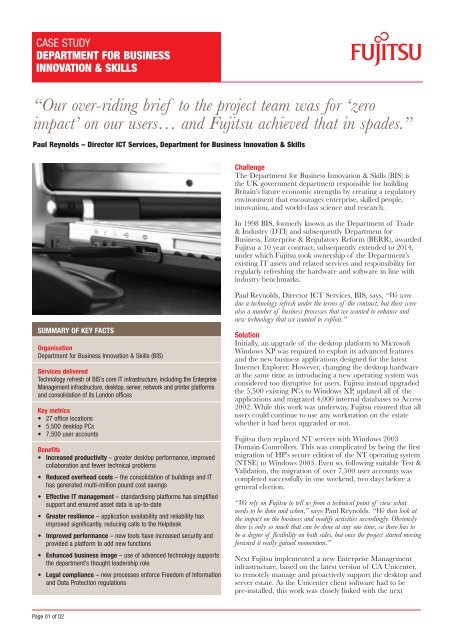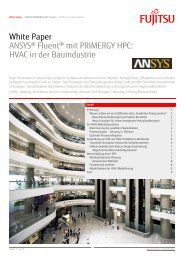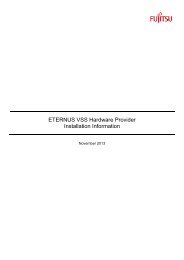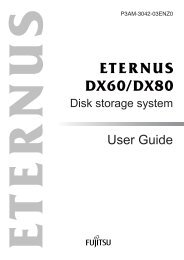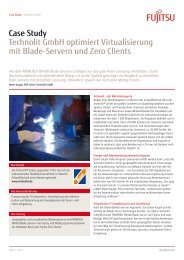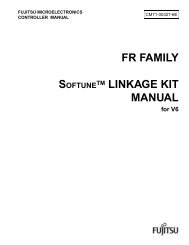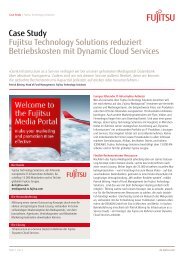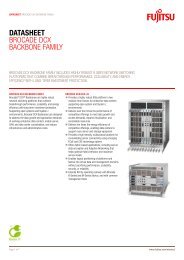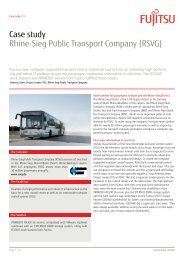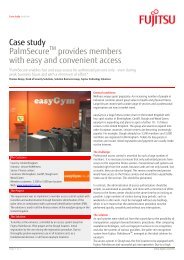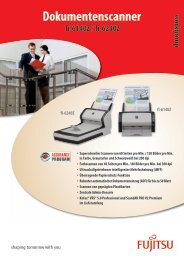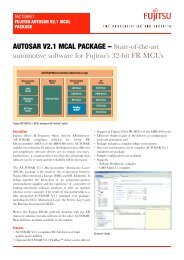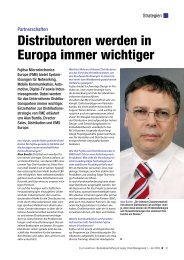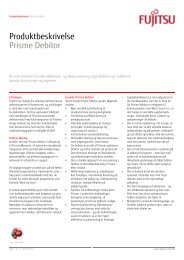8808 Fujitsu DTI - Tech Refresh case study
8808 Fujitsu DTI - Tech Refresh case study
8808 Fujitsu DTI - Tech Refresh case study
You also want an ePaper? Increase the reach of your titles
YUMPU automatically turns print PDFs into web optimized ePapers that Google loves.
CASE STUDY<br />
DEPARTMENT FOR BUSINESS<br />
INNOVATION & SKILLS<br />
“Our over-riding brief to the project team was for ‘zero<br />
impact’ on our users… and <strong>Fujitsu</strong> achieved that in spades.”<br />
Paul Reynolds – Director ICT Services, Department for Business Innovation & Skills<br />
Challenge<br />
The Department for Business Innovation & Skills (BIS) is<br />
the UK government department responsible for building<br />
Britain’s future economic strengths by creating a regulatory<br />
environment that encourages enterprise, skilled people,<br />
innovation, and world-class science and research.<br />
In 1998 BIS, formerly known as the Department of Trade<br />
& Industry (<strong>DTI</strong>) and subsequently Department for<br />
Business, Enterprise & Regulatory Reform (BERR), awarded<br />
<strong>Fujitsu</strong> a 10 year contract, subsequently extended to 2014,<br />
under which <strong>Fujitsu</strong> took ownership of the Department’s<br />
existing IT assets and related services and responsibility for<br />
regularly refreshing the hardware and software in line with<br />
industry benchmarks.<br />
SUMMARY OF KEY FACTS<br />
Organisation<br />
Department for Business Innovation & Skills (BIS)<br />
Services delivered<br />
<strong>Tech</strong>nology refresh of BIS’s core IT infrastructure, including the Enterprise<br />
Management infrastructure, desktop, server, network and printer platforms<br />
and consolidation of its London offices<br />
Key metrics<br />
• 27 office locations<br />
• 5,500 desktop PCs<br />
• 7,500 user accounts<br />
Benefits<br />
• Increased productivity – greater desktop performance, improved<br />
collaboration and fewer technical problems<br />
• Reduced overhead costs – the consolidation of buildings and IT<br />
has generated multi-million pound cost savings<br />
• Effective IT management – standardising platforms has simplified<br />
support and ensured asset data is up-to-date<br />
• Greater resilience – application availability and reliability has<br />
improved significantly, reducing calls to the Helpdesk<br />
• Improved performance – new tools have increased security and<br />
provided a platform to add new functions<br />
• Enhanced business image – use of advanced technology supports<br />
the department’s thought leadership role<br />
• Legal compliance – new processes enforce Freedom of Information<br />
and Data Protection regulations<br />
Paul Reynolds, Director ICT Services, BIS, says, “We were<br />
due a technology refresh under the terms of the contract, but there were<br />
also a number of business processes that we wanted to enhance and<br />
new technology that we wanted to exploit.”<br />
Solution<br />
Initially, an upgrade of the desktop platform to Microsoft<br />
Windows XP was required to exploit its advanced features<br />
and the new business applications designed for the latest<br />
Internet Explorer. However, changing the desktop hardware<br />
at the same time as introducing a new operating system was<br />
considered too disruptive for users. <strong>Fujitsu</strong> instead upgraded<br />
the 5,500 existing PCs to Windows XP, updated all of the<br />
applications and migrated 4,000 internal databases to Access<br />
2002. While this work was underway, <strong>Fujitsu</strong> ensured that all<br />
users could continue to use any workstation on the estate<br />
whether it had been upgraded or not.<br />
<strong>Fujitsu</strong> then replaced NT servers with Windows 2003<br />
Domain Controllers. This was complicated by being the first<br />
migration of HP’s secure edition of the NT operating system<br />
(NTSE) to Windows 2003. Even so, following suitable Test &<br />
Validation, the migration of over 7,500 user accounts was<br />
completed successfully in one weekend, two days before a<br />
general election.<br />
“We rely on <strong>Fujitsu</strong> to tell us from a technical point of view what<br />
needs to be done and when,” says Paul Reynolds. “We then look at<br />
the impact on the business and modify activities accordingly. Obviously<br />
there is only so much that can be done at any one time, so there has to<br />
be a degree of flexibility on both sides, but once the project started moving<br />
forward it really gained momentum.”<br />
Next <strong>Fujitsu</strong> implemented a new Enterprise Management<br />
infrastructure, based on the latest version of CA Unicenter,<br />
to remotely manage and proactively support the desktop and<br />
server estate. As the Unicenter client software had to be<br />
pre-installed, this work was closely linked with the next<br />
Page 01 of 02
CASE STUDY<br />
DEPARTMENT FOR BUSINESS<br />
INNOVATION & SKILLS<br />
phase of the desktop refresh in which over 5,300 new<br />
workstations were deployed across 27 locations.<br />
For the first time in government, the new desktops were also<br />
configured with Windows XP Service Pack 2. <strong>Fujitsu</strong> then<br />
added new file servers to the IT estate and migrated all user<br />
data and shared drives onto them. It also moved the e-mail<br />
system to Microsoft Exchange 2003, reducing the number of<br />
Exchange servers from 24 to just 8.<br />
The effectiveness of the e-mail management service was<br />
enhanced with a new Storage Area Network (SAN) and<br />
archive solution, based on Symantec’s Enterprise Vault software<br />
and <strong>Fujitsu</strong>’s Eternus SAN Storage System. Designed to<br />
enforce a new e-mail archiving and deletion policy, improve<br />
information retrieval and free up expensive server storage<br />
space, the solution is the first implementation in government<br />
of an e-mail management system using this type of seamlessly<br />
integrated SAN storage.<br />
At the same time, <strong>Fujitsu</strong> was also playing a key role in the<br />
Department’s “two roof ” project, which consolidated the<br />
number of London offices from eight to two. To effect this<br />
major change, <strong>Fujitsu</strong> had to work very closely with the<br />
estate staff and numerous subcontractors to dovetail the<br />
upgrades with equipping the new offices, refreshing the network<br />
and moving hundreds of staff into new premises.<br />
Finally, <strong>Fujitsu</strong> upgraded the network infrastructure with new<br />
hubs, switches and routers and migrated it to <strong>Fujitsu</strong>’s own<br />
MPLS network for added resilience. New Proxy Servers were<br />
also implemented to enable faster Internet access and a new<br />
Internet search service was put in place for BIS’ websites.<br />
Printers have also been standardised and centralised to make<br />
them easier to use, while reducing the costs of support,<br />
spares and consumables.<br />
“Without doubt the tech refresh programme has exceeded my expectations,”<br />
comments Paul Reynolds. “One example is using centralised printers,<br />
where we’ve taken 800 printers out and now only have 50, so it’s saving<br />
us a lot of money just on consumables. Much more noticeable have been<br />
the complimentary e-mails that we’ve had from users saying that they<br />
wished all projects were run like this!<br />
“Our over-riding brief to the project team was for ‘zero impact’ on our<br />
users, everything had to be transparent to them, and <strong>Fujitsu</strong> achieved<br />
that in spades. For example, <strong>Fujitsu</strong> put two new e-mail gateways in<br />
and there was absolutely no adverse impact on the users. Given the<br />
complexity of the project I would have expected one or more of the<br />
components to fail, but that simply never happened.”<br />
Benefits<br />
The newly refreshed IT infrastructure has provided BIS with<br />
considerable cost and efficiency benefits:<br />
• Increased user productivity – with much greater power<br />
and performance at the desktop, improved collaboration and<br />
fewer technical problems<br />
• Reduced overhead costs – the consolidation of buildings and<br />
IT infrastructure has generated multi-million pound cost savings<br />
• Effective IT management – standardising the desktop,<br />
server and printer platforms has simplified support and<br />
ensured asset information is fully up-to-date<br />
• Greater system resilience – application availability and<br />
reliability has improved significantly, reducing the number of<br />
calls to the Service Centre<br />
• Improved operational performance – new tools, such as<br />
Active Directory, have increased security immensely and<br />
provided a platform for new functions, such as identity<br />
management<br />
• Enhanced business image – the use of advanced technology<br />
supports the department’s thought leadership role and<br />
enhances customer confidence<br />
• Legal compliance – new processes enforce Freedom of<br />
Information and Data Protection regulations.<br />
Paul Reynolds says, “As a result of <strong>Fujitsu</strong>’s work on the technology<br />
refresh project we’ve had one of the longest periods of availability that we’ve<br />
had for a long, long time. We’ve also made enormous savings, including some<br />
£13 million a year on building costs alone. Now we can start to bring on<br />
the full capability of the new systems. By turning on the ‘switches’ we can<br />
give many more benefits to the user community with minimal risk and effort.”<br />
Approach<br />
Close collaboration in the planning of the technology refresh<br />
programme was critical to its success. Not only did members<br />
of BIS sit on <strong>Fujitsu</strong>’s Programme Board and vice versa, but<br />
a dedicated intranet was set-up at the start of the<br />
programme to ensure that all users had a common source of<br />
accurate and up-to-date information.<br />
“There is a huge change schedule maintained by <strong>Fujitsu</strong> and ourselves,<br />
just as part of our day-to-day life, such as office moves and new<br />
applications,” explains Paul Reynolds. “On average there are<br />
around 18-20 changes a night, some of which can be quite large.<br />
Making sure that all of these things are completed successfully without<br />
affecting the users, requires extremely tight planning and control and is a<br />
major undertaking by both organisations.”<br />
Expertise<br />
With over 30 years experience of supporting the needs of<br />
customers, <strong>Fujitsu</strong> has a proven track record in providing<br />
complex systems integration and management services that<br />
reduce costs, improve productivity and customer services and<br />
deliver a compelling return on investment.<br />
Paul Reynolds says, “This was not a typical technical solution by<br />
which you just install something then go around fixing the bits that don’t<br />
work. Instead we set some fundamental ground rules, like no impact on<br />
the business and a need for full planning, because we simply didn’t want<br />
any major problems to fix. This approach is not always popular with<br />
IT specialists and requires an ability to think in a different ways. Even<br />
so, <strong>Fujitsu</strong> understood our business drivers and achieved what we wanted<br />
thanks to some very careful and tight project management and some free<br />
and frank discussions, which we really valued. When you look back at<br />
how technically complex the project was and what could have gone<br />
wrong at any number of points you realise just how far we’ve come.”<br />
Page 02 of 02<br />
2393<br />
© Copyright <strong>Fujitsu</strong> Limited 2009. Created July 09. Ref: 2206 <strong>Fujitsu</strong> endeavours to ensure that the information in this<br />
document is correct and fairly stated, but does not accept liability for any errors or omissions.


